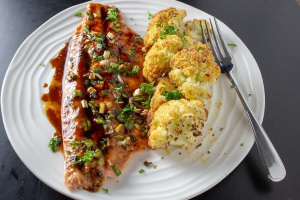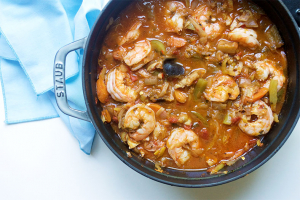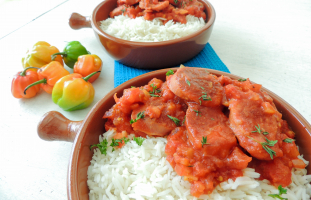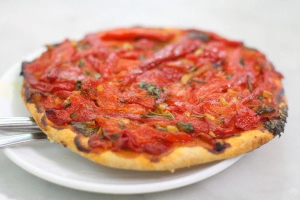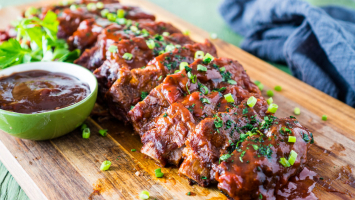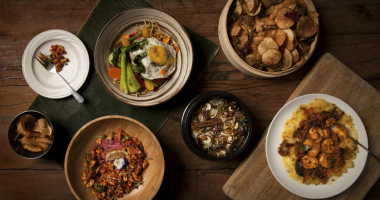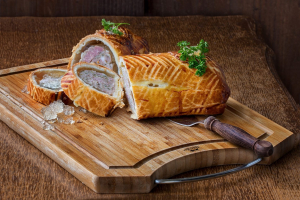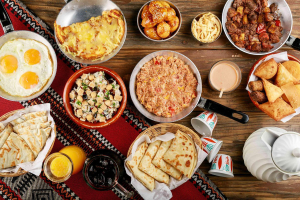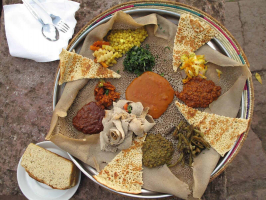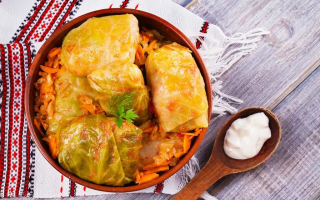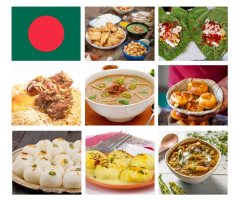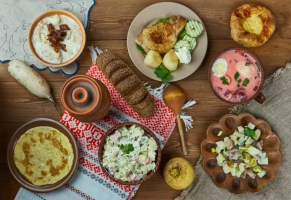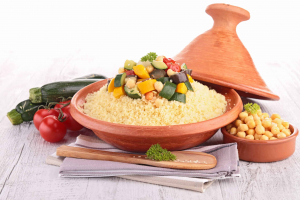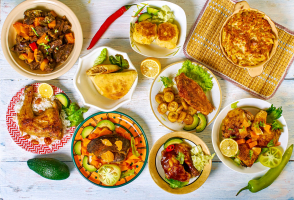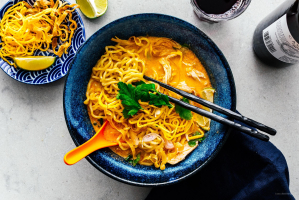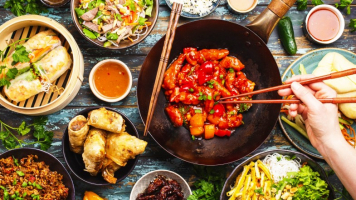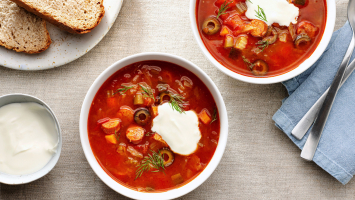Top 10 Best Foods In Singapore With Recipe
Singaporean food is as ethnically diverse as its people, integrating elements from Malay, Chinese, Indonesian, Indian, and Western cultures. A trip to one of ... read more...the hawker centres or shopping mall food courts will be both educational and delicious. This list includes what Toplist considers to be the best examples of Singaporean cuisine, ranging from simple street food vendors to luxurious rooftop restaurants and everything in between.
-
Poached chicken and seasoned rice are served with a chilli sauce and cucumber garnishes in Hainanese chicken rice. It was modified from the Hainanese cuisine Wenchang chicken by immigrants from Hainan in southern China. It is regarded as one of Singapore's national dishes and is most closely connected with Singaporean cuisine. The dish is popular in Southeast Asia, notably in Indonesia and Malaysia, where it is a mainstay of the cuisine. Rice cooked in chicken broth served with steamed chicken. This classic recipe is perfect for a fast and substantial lunch. The steamed rice bursting with flavor and a fragrant perfume is a testament to the high quality of the chicken stock used in this meal. Toss the chicken with some dipping sauce and try it.
Ingredients
- HAINANESE CHICKEN
- 3 lb whole chicken(1.3 kg), giblets removed
- ¼ cup kosher salt(60 g), divided
- 4 inch pieces fresh ginger, peeled and cut into ¼-inch (6 mm) slices
- 1 bunch fresh scallion
- 1 gal cold water(3.7 L), plus more as needed
- 2 tablespoons sesame oil
- HAINANESE RICE
- ¼ cup sesame oil(60 mL)
- 2 tablespoons chicken fat, chopped
- 2 cloves garlic, minced
- 1 tablespoon fresh ginger, minced
- 1 teaspoon kosher salt
- 2 cups long grain rice(400 g), rinsed and drained
- 2 cups reserved chicken poaching broth(480 mL)
Preparation
- To clean the chicken, rub a pinch of kosher salt all over it to remove any loose skin. Rinse the chicken well on the inside and out. Using paper towels, pat dry.
- Remove any extra fat from the chicken and save it for another use.Season the chicken with salt and pepper. Fill the
- cavity of the chicken with ginger slices and scallions.
- Season the chicken with salt to taste and place it in a large stock pot with 1 inch (2 cm) of cold water.
- Bring to a boil over high heat, then lower to a medium heat to maintain a gentle simmer. Cook for about 30 minutes, or until the chicken reaches an internal temperature of 165°F (75°C). Turn off the heat in the saucepan.
- To end the cooking process and preserve the chicken skin elastic, remove the chicken from the saucepan and place it in an ice bath for 5 minutes, keeping the poaching liquid. Remove the ginger and green onion and toss them out.
- After the chicken has cooled, blot it dry with paper towels and massage it with sesame oil all over. This will keep the chicken moist and prevent it from drying out.
- Heat 14 cup (60 ml) sesame oil in a large wok or pan over medium-high heat. 2 tablespoons saved chopped chicken fat, garlic, ginger, and salt are added to the pan and cooked until fragrant, about 10 minutes.
- 14 of the fried garlic mixture should be set aside, and the remaining fried garlic should be stirred in to coat the rice. 3 minutes in the oven
- Add 2 cups (480 ml) of the saved poaching stock to the rice in a rice cooker. Cook the rice in a steamer for 60 minutes, or until it is soft.
- Carve the chicken for dishing while the rice is cooking.
In a small mixing bowl, add the sambal, Sriracha, sugar, garlic, ginger, lime juice, and chicken broth and toss to blend. - To make the ginger garlic sauce, mix the ginger, garlic, salt, peanut oil, and rice vinegar in a small bowl and whisk to blend.
- To make the soy sauce, put the reserved fried garlic and ginger, oyster sauce, dark soy sauce, light soy sauce, and chicken broth in a small mixing bowl and swirl to blend.
- Slice the chicken and serve it with rice, dipping sauces, cucumber slices, and fresh cilantro.
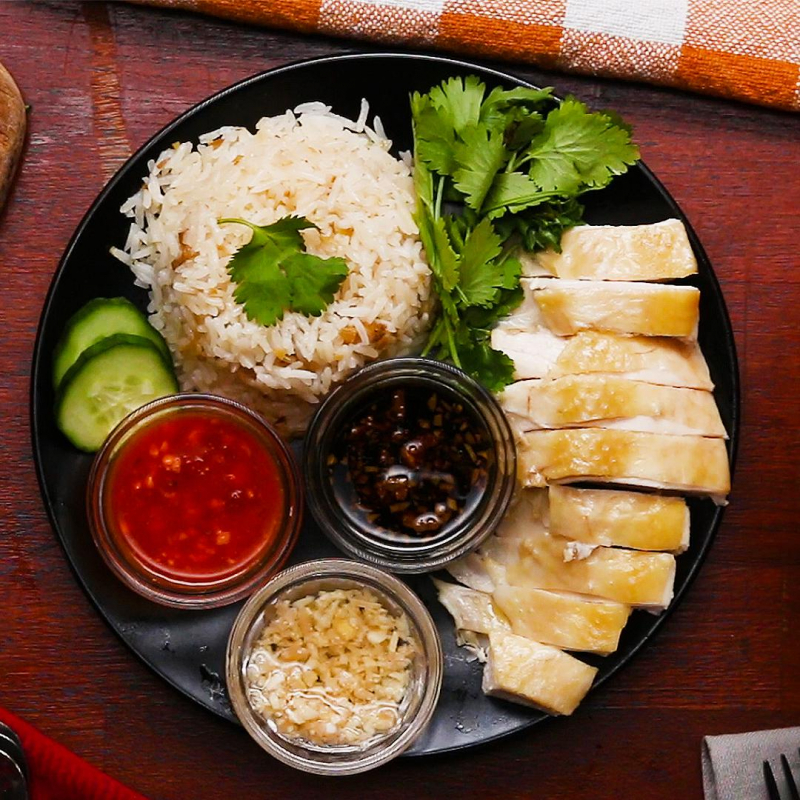
Photo: tasty.co 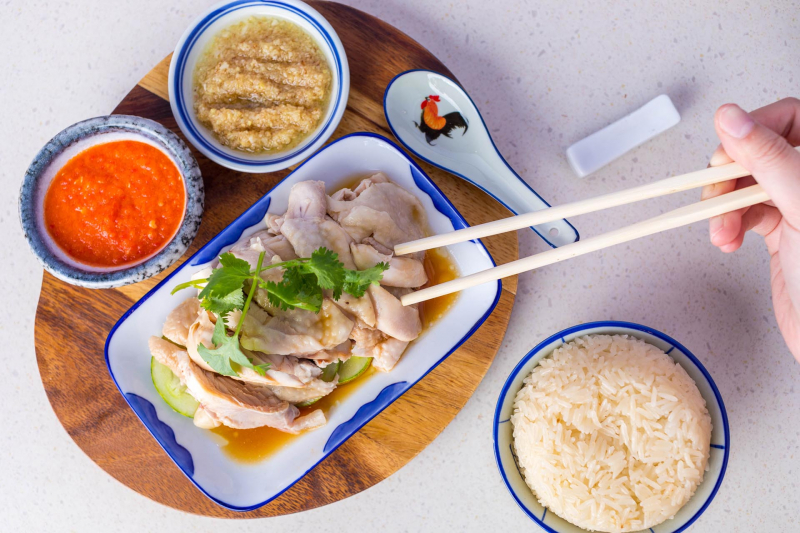
Photo: asianfoodnetwork.com -
Cher Yam Tian invented the chili crab in Singapore in the 1950s. Her crabs became a popular when she experimented in her kitchen for family and friends, and her family built their first restaurant, Palm Beach Seafood. Since then, the dish has been a mainstay on Singaporean menus, from hawker centers to fine dining establishments. Dining out on chili crab in Singapore may be pricey, and they all know you'll never be able to finish a feast of crab. Cooking crab at home is unquestionably the best option. Mud crabs from Sri Lanka are used in Singapore, although any other crab, even soft-shelled crabs, should work.
Ingredients
- 1 tablespoon (8g) cornstarch
- 2 tablespoons (30g) water
- 7 tablespoons (104ml) peanut oil
- 2 to 3 whole shallots, minced (about 1/2 cup)
- 1 1/2-inch knob ginger, grated (about 2 tablespoons)
- 6 medium garlic cloves, minced (about 2 tablespoons)
- 4 Thai chiles, minced
- 2 whole Mud or Dungeness crabs (about 1 pound each), prepared (see note)
- 2 cups (500ml) homemade or store-bought low sodium chicken broth
- 1/4 cup (66g) tomato paste
- 1/2 cup (125ml) hot-sweet chili sauce (see note)
- Salt, to taste
- Sugar, to taste
- 1 large egg, beaten
- 1/2 cup thinly sliced green onions
- 1 cup fresh cilantro leaves
Preparation
- Whisk together 2 tablespoons water and cornstarch in a small dish; leave aside. Heat the oil in a big wok with a cover (or a Dutch oven) over medium heat until it shimmers. Add the shallots, ginger, garlic, and chilies and mix well. Cook and stir for 1 minute, or until aromatic.
- Add the crab chunks and the broth to the pot. Raise the heat to medium-high and bring the mixture to a boil. Cover loosely and gently boil for 6 minutes, or until crab has become red and is nearly cooked through (lower heat if required).
- Remove the lid and add the tomato paste and chili sauce to the pan. Simmer for 1 minute, then season with salt, sugar, or chili sauce to taste. To thicken, stir in the cornstarch mixture and bring to a boil.
- Remove the pan from the heat and whisk in the egg. Green onions should be added at this point. Serve by ladling onto a serving dish and garnishing with cilantro.
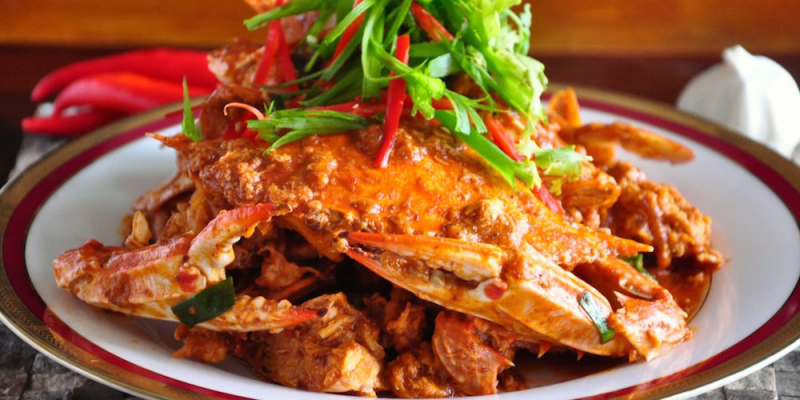
Photo: thongtindulich 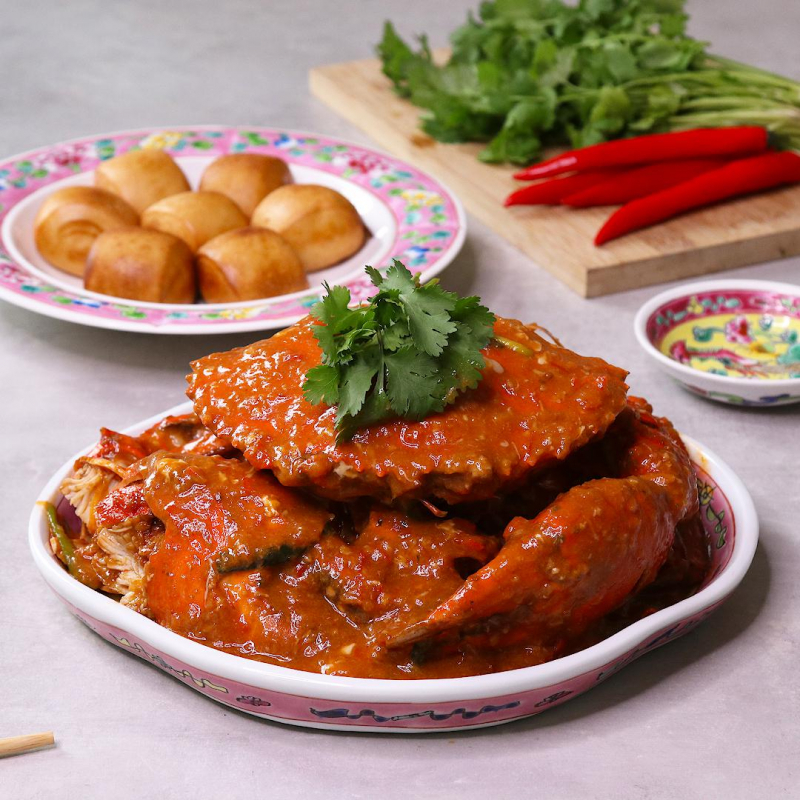
Photo: tasty.co -
In Southeast Asia, laksa is a spicy noodle meal. Laksa is made out of a variety of noodles, the most common of which are thick rice noodles, with toppings such as chicken, prawns, or fish. A thick and spicy coconut soup or a broth seasoned with sour asam are used in most laksa varieties (tamarind or gelugur). A mix between Chinese and Malay cuisine, rice noodles in a spicy coconut curry soup with shrimp, fish cakes, egg, and chicken meat. There are several other types of laksa, but the one popular in Singapore is katong laksa, which uses cut-up noodles. Cockles and tofu puffs are occasionally included.
Ingredients
- 8 king prawns, de-shelled
- 1 tablespoon palm sugar
- 1 tablespoon fish sauce
- 1 ¼ cups coconut milk(400 mL)
- ¼ lb tofu puffs(100 g), tau pok, halved
- 2 tablespoons cooking oil
- PRAWN STOCK:
- 8 king prawns, head and shells
- 5 cups water(1.2 mL)
- 2 cups chicken stock(480 mL)
- 2 tablespoons cooking oil
- LAKSA PASTE:
- 15 dried chillies
- 2 red chillis
- 3 tablespoons dried shrimp, soaked
- 1 teaspoon shrimp paste, belacan
- 8 cloves garlic
- 1 shallot
- 1 ginger, 1 in (2.5 cm)
- 1 blue ginger, galangal - 1in (2.5 cm)
- turmeric root, 2 in (5 cm)
- ¼ cup candle nuts(30 g)
- 1 stalk lemongrass
Preparation
- Remove the heads and shells from the prawns and set aside in a separate bowl, then devein and set aside the prawn flesh.
- In a large saucepan over medium-high heat, add cooking oil to produce the prawn stock. Stir in the prawn heads and shells for 5 minutes, smashing the heads to unleash their flavor.
- Pour in the water and chicken stock, then decrease the stock for 45 minutes.
- Remove the prawn shells and drain the liquid through a strainer into a basin.
- Add the dried chilies, red chilies, dried shrimp, shrimp paste (belacan), garlic, shallot, ginger, blue ginger (galangal), turmeric root, candle nuts, and lemongrass stalk to a food processor and pulse for 5 minutes, or until a thick paste forms.
- In a large saucepan, heat the cooking oil, then add the laksa paste and cook for 5 minutes, or until aromatic. Stir in the palm sugar, fish sauce, coconut milk, and prawn stock. Simmer for 15 minutes, then add the prawns and tofu puffs and simmer for another 3 minutes.
- To serve, toss vermicelli noodles in a dish with bean sprouts, cockles, and fish cake pieces. Scoop the laksa into the bowls, making sure to incorporate the tofu puffs and prawns. Add a handful of finely chopped laksa leaves and a dash of chilli paste if desired.
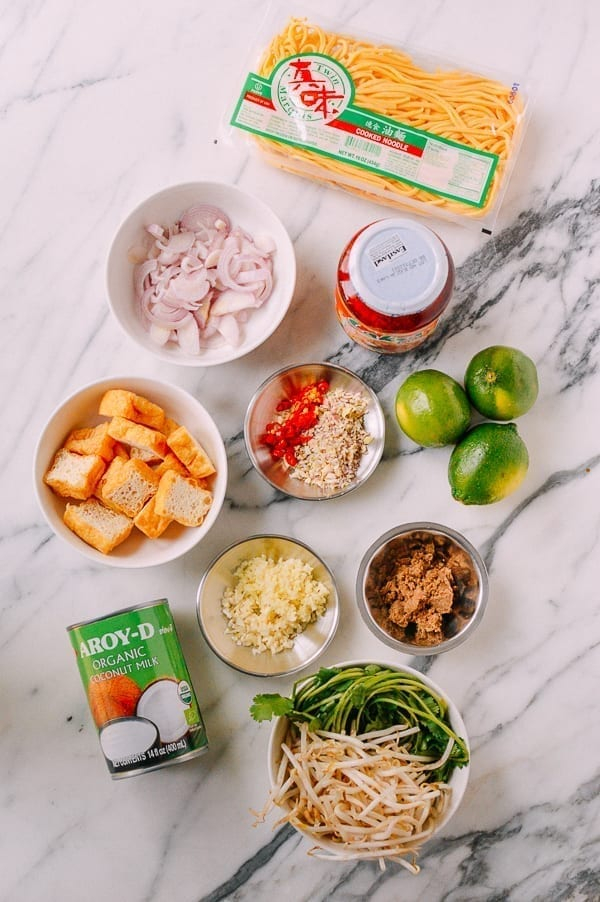
Photo: thewoksoflife.com 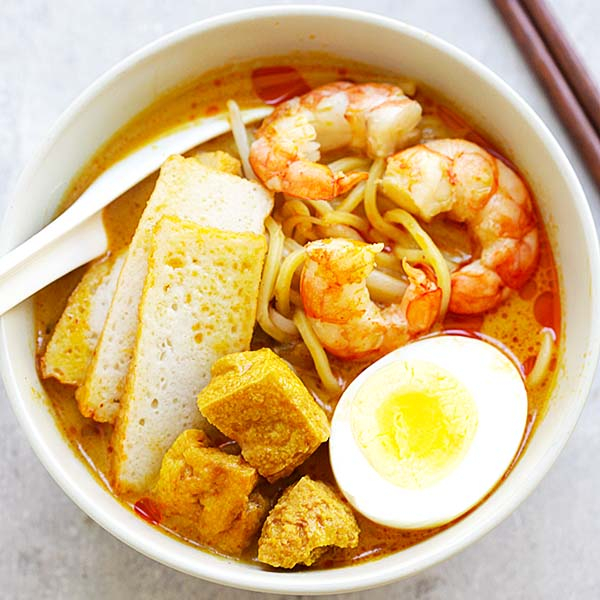
Photo: rasamalaysia.com -
Broad white noodles, bean sprouts, fish cake, clams, and Chinese sausage cooked in black Soya sauce. This dish may be found at hawker centers and restaurants. By cooking the noodles at a high temperature, skilled cooks will impart a smokey flavor to the meal.
Ingredients
- 8 ounces dried wide rice noodles or 1 pound fresh rice noodles(225g dried or 450g fresh)
- 2 teaspoons dark soy sauce
- 2 tablespoons regular soy sauce
- 1 tablespoon fish sauce
- 1 teaspoon shrimp paste or shrimp sauce
- 1 tablespoon oyster sauce
- ⅛ teaspoon white pepper
- 1 teaspoon sugar
- 3 tablespoons vegetable oil (divided)
- 2 Chinese sausages (about 115g, sliced ⅛ inch thick)
- 2 cloves garlic (sliced)
- 4 ounces shrimp (115g, 31 to 40 size)
- 4 ounces fish cake or fish tofu, thinly sliced (115g)
- 4 ounces garlic chives (115g, cut into 2 ½-inch pieces)
- 1 tablespoon shaoxing wine (optional)
- 1 egg (lightly beaten)
- 6 ounces mung bean sprouts (170g)
Preparation
- Soak the dry noodles for 30 to 45 minutes in warm water. Allow the extra water to drain in a strainer. Cut new rice noodles into 112-inch broad strips and lay aside. Judy's recipe for Homemade Rice Noodles may also be used to make your own rice noodles at home.
- In a small bowl, combine 2 teaspoons dark soy sauce, 2 tablespoons light soy sauce, 1 tablespoon fish sauce, 1 teaspoon shrimp paste, 1 tablespoon oyster sauce, 18 teaspoon ground white pepper, and 1 teaspoon sugar. Set aside after mixing until well blended.
- Preheat your wok to medium-high heat and coat the outside with 1 tablespoon of vegetable oil. Add the sliced Chinese sausages and stir-fry for 20 seconds.
- Toss in the 2 garlic cloves, the shrimp, and the fish tofu. Stir-fry for a further 20 seconds.
- Increase the heat in the wok to high. 1 tablespoon shaoxing wine, spread over the wok's perimeter
- Stir for a further 15 seconds. Toss in the noodles. Fold them in gently with the rest of the ingredients. To allow the sides of the wok to superheat, gather everything in the centre of the pan. Spread another tablespoon of vegetable oil around the edge of the pan and pour the sauce mixture equally over the noodles.
- Add the garlic chives next. To obtain the wok hay sear from the superheated sides of the wok, gently stir the noodles (to reduce breaking) while distributing them over the perimeter of the wok. The rice noodles should not cling due to the hot pan and oil.
- While the noodles are scorching, rapidly make a hole in the bottom of the pan and pour in the remaining tablespoon of oil, along with the gently beaten egg. To cook and break up the egg, stir it around for 15 seconds. If you're a novice chef, you might wish to pre-cook the egg the first time!
- After that, add the mung bean sprouts and gently combine for 1 minute.
- If your Char Kway Teow seems to be dry, toss in 2 tablespoons of water when stir-frying the noodles. If desired, a little additional vegetable oil can be added. On the side, serve your char kway teow with chili garlic paste or homemade chili oil.
- Using a peeler, make cucumber ribbons. Get your youngster to peel the cucumber into a bowl with a swivel-blade peeler, then continue peeling the cucumber flesh into ribbons until they reach the seeds. Rep with the other cucumber side.
- Toss the cucumbers in a cucumber dressing. Encourage your child to stir the vinegar and sugar together until the sugar dissolves, and then explain what dissolves means. If using, add the sweet chilli, then pour over the cucumber. If your youngster enjoys coriander, add it, or offer it on the side for the adults. Serve the skewers on a tray with rice and lime wedges on the side, and the sauce and salad in bowls.
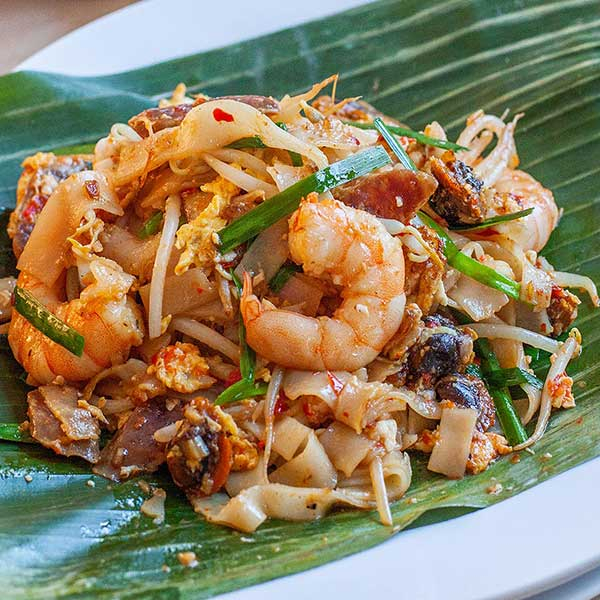
Photo: sgtiepthi.vn 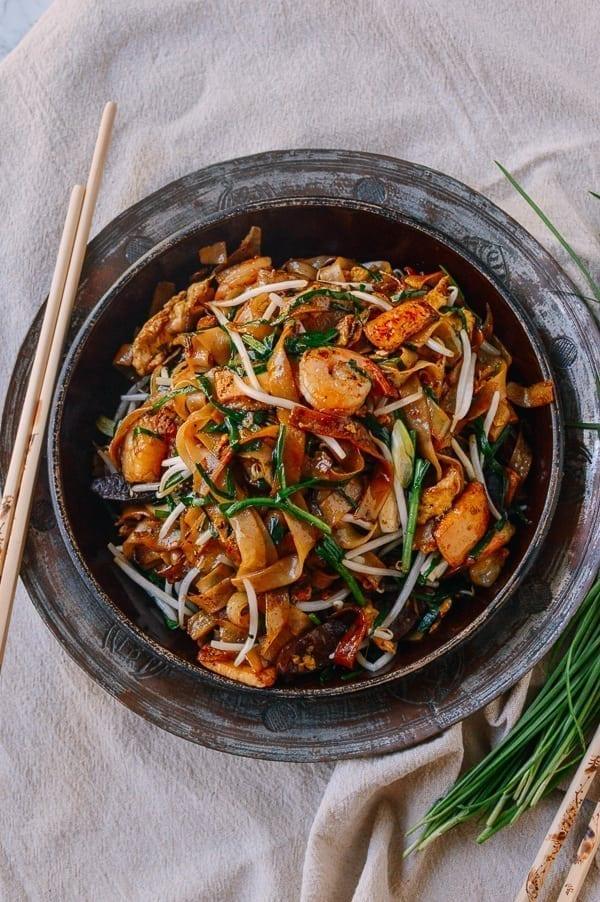
Photo: thewoksoflife.com -
The all-time favorite local dish is fried Hokkien Prawn Mee or Noodles. The noodles' smooth, silky texture, infused with umami-filled prawn-y sweetness, is just enticing. Hokkien noodles stir-fried with prawns, chicken or pig pieces, squid, and fish cake, seasoned with soy sauce, vinegar, and chillies. To balance off the greasy flavor, each plate comes with sambal sauce and a lime slice. In Singapore, thick, flat egg noodles are used.
Ingredients
- STOCK:
- 1 bag shrimp heads and shells, (Ziploc Easy Zipper Bag)
- 15 cups water, reduced to about 12-13 cups of water after hours of boiling and simmering
- 2-3 pieces rock sugar, about the size of a small ping pong ball each, or to taste
- 1.5 lbs. (0.6 kg) pork ribs, cut into pieces
- salt to taste
- CHILI PASTE:
- 30 dried chilies, seeded and soaked to soften
- 10 shallots, peeled
- 5 cloves garlic, peeled
- 2 tablespoons water
- 6 tablespoons cooking oil
- 1 pound (0.4 kg) yellow noodles, scalded
- 1 pack rice vermicelli, scalded
- kangkong or water convolvulus, scalded
- bean sprouts, scalded
- TOPPINGS:
- 1/2 pound (0.2 kg) lean pork meat, boiled and sliced thinly
- 1/2 pound (0.2 kg) shrimp, shelled and deveined
- 6 hard-boiled eggs, shelled and quartered
- fried shallot crisps, store-bought
Preparation
- Using a tiny food processor, puree the chili paste components until finely ground and fully combined. Cooking oil is added to a hot wok. For 5 minutes, stir fry the chili paste. Prepare the dish and leave it aside. Add a little oil to the same unwashed wok and fry the shrimp topping. Add a pinch of chili paste, sugar, and salt to taste. The shrimp were pan-fried until they were slightly burnt. Dish them out, let them cool, and then cut them in half.
- Fill a saucepan halfway with water and bring it to a boil. Add in all of the shrimp heads and shells, and cook on low heat for 2 hours or longer, until the stock is murky and prawny.
- Transfer the stock to a new pot after straining it through a sieve. Remove the shrimp heads and shells and toss them out. Scoop up and discard the orange "foam" that has formed on the stock's top.
- Bring the liquid back up to a boil, then add half of the chili paste. If you want it to be hotter, add additional chili paste.
- Add the pork ribs and simmer for another 1-1.5 hours on low heat, or until the pork ribs are fully cooked.
- To taste, add rock sugar and salt.
- Fill a dish halfway with yellow noodles, rice vermicelli, water convolvulus, and bean sprouts to serve. Ladle hot stock over. Add a couple chunks of pork ribs if desired. Cut pig meat, sliced shrimp, egg quarters, and shallot crisps are sprinkled on top.
- Serve right away with more chili paste to taste.
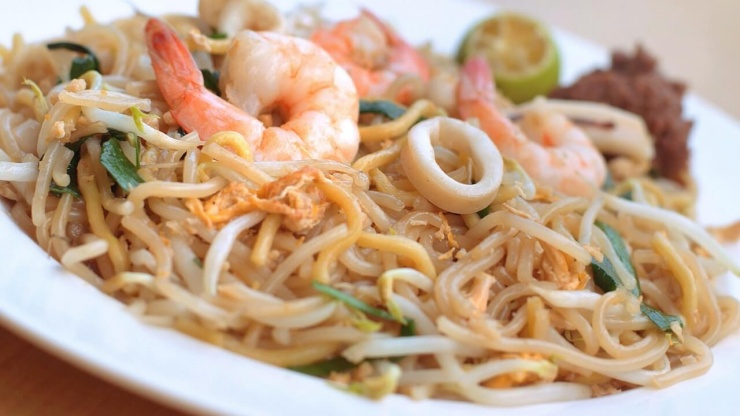
Photo: visitsingapore.com 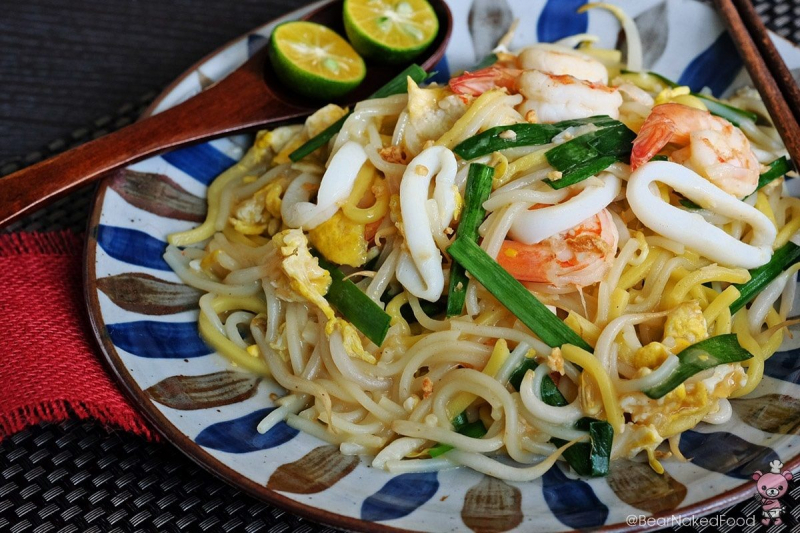
Photo: bearnakedfood.com -
Barbecued stingray is a famous fish dish offered at hawker stalls that originated on the streets. The traditional form involves marinating stingray flesh in a thick sambal sauce (a spicy condiment made with chopped tomatoes, chiles, and shrimp paste) before wrapping it in banana leaf and grilling it gently.
Ingredients
- 750 g stingray or snapper ( I prefer the stingray )
- 2 tbsp lime juice
- Pinch of salt
- 2 tsp sugar
- 3 tbsp olive oil
- 3 tbsp fish curry pwd
- 3 red chilliesshopping list
- 3 stalks lemongrass chopped
- 300 ml low fat evaporated milk
- 30 g garlic and ginger
- 30 g dried prawns or 3 tsp shrimp paste
- 100 g shallots
Preparation
- Rub the lime juice and salt on the fish and set aside for 10 mins
- Fry everythingelse with salt for 10 mins or until the oil separates
- Cool the paste .
- Spread it over the fish and leave for 10 mins
- Wrap in a banana leaf and bbq
- Place in a sheet of aluminium foil on a heated frying pan .
- Brush it lightly with olive margarine .
- Cook on medium heat on both sides until the fish is done .
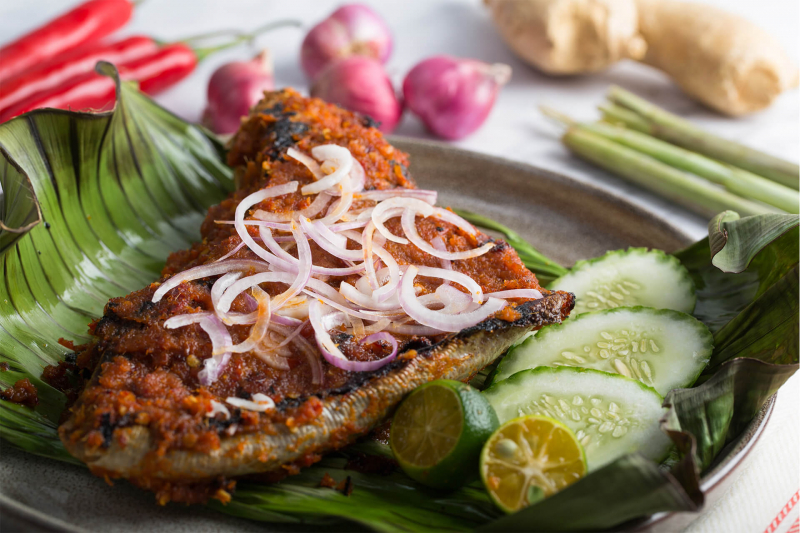
Photo: eatbook.sg 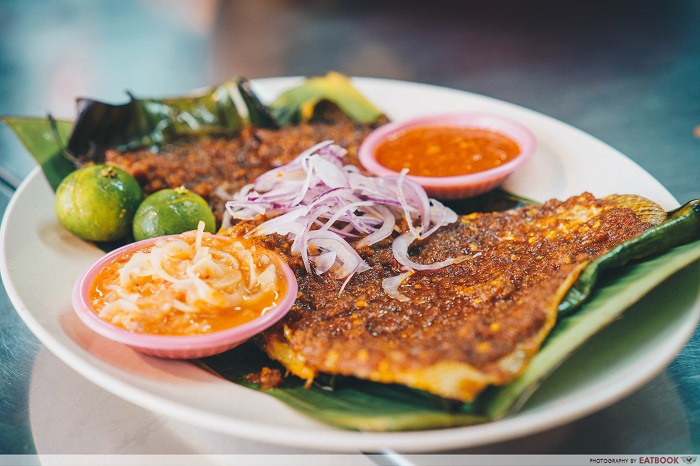
PHoto: asianfoodnetwork.com -
Fish head curry was created in Singapore by M.J. Gomez, a chef from Kerala who was staying there and wanted to introduce South Indian cuisine to local consumers. He opened a restaurant called Gomez Curry, which was first located on Sophia Road and then on 9 Selegie Road in the Rochor neighborhood of the Central Region. Although fish head casserole was not generally offered in the Indian subcontinent, Chinese clients thought it was a particular delicacy, so Gomez came up with the concept of cooking the fish in curry with his own seasonings, thereby creating a new meal.
Ingredients
- 1/2 to 2 fish heads, depending on size, about 5 pounds total
- 2 tablespoons vegetable oil
- 1/4 cup red or green Thai curry paste
- 3 tablespoons fish sauce or anchovy sauce
- 1 tablespoon sugar
- 1 can coconut milk, about 12 ounces
- 3 medium size asian eggplants, cut int 1 inch rounds
- Handful of bird's eye chilies
- 1/2 cup Thai basil leaves
- Juice of 3 limes
Preparation
- Using cold water, rinse the fish heads. If they're bloodied, immerse them in a bowl of water for a few minutes before rinsing them again.
- In a large deep pot, heat the oil over low heat. Cook, stirring constantly, until the curry paste is aromatic and begins to adhere to the bottom of the pan. Turn off the heat.
- Combine the fish sauce, sugar, coconut milk, and chillies in a mixing bowl. Bring the water to a boil.
- Meanwhile, sauté the eggplant in a few teaspoons of oil or roast until brown, about 10 minutes at 350°F. Remove the pan from the heat and set it aside.
- In a separate bowl, combine the fish head and eggplant with the curry coconut mixture. Add enough water to completely submerge the fish head. Cook for 10 minutes, or until the meat is soft and just cooked through, on a low heat. Stir in the basil leaves just before serving.
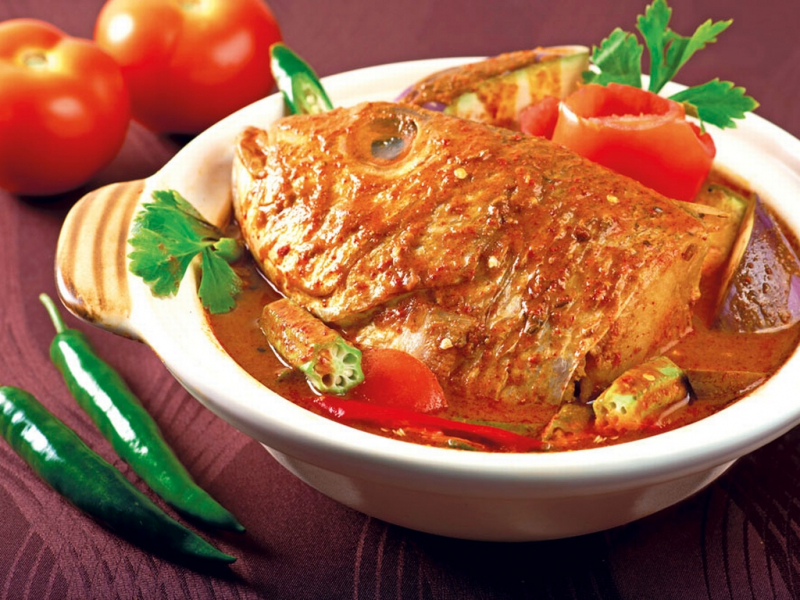
Photo: brendafmss.wordpress.com 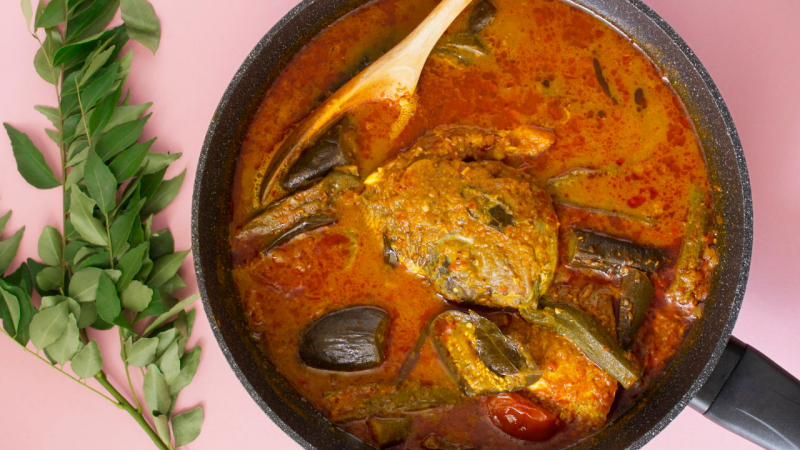
Photo: nyonyacooking.com -
Satay, often known as chicken satay, conjures up images of properly grilled and attractively charred chicken skewers topped with delectable peanut sauce. Grilled beef on skewers served with ketupat (rice cake), peanut sauce, and cucumber-chili relish. This popular side dish is a great starter or plate for a party. Because turmeric is the main marinade ingredient, it has a distinct turmeric fragrance and flavor. Pork, chicken, beef, or mutton are all options.
Ingredients
- small piece ginger
- 2 garlic cloves
- zest and juice 1 lime
- 1 tsp clear honey
- 1 tbsp soy sauce
- 1 tbsp mild curry powder
- 3 tbsp smooth peanut butter
- 500g pack skinless chicken breast fillets
- 165ml can coconut milk
- 1 tsp vegetable oil
- cooked rice and lime wedges, to serve
- For the cucumber salad
- 1 cucumber
- 2 tbsp white wine vinegar
- 1 tbsp golden caster sugar
- sweet chilli sauce (optional)
- bunch coriander leaves picked (optional)
Preparation
- KIDS The bolded text is for you. THE REST IS FOR THE GROWN-UPS. Make a delectable marinade. Peel the ginger and assist them in grating it finely into a bowl. Replace the garlic and lime zest and repeat the process. Halve the lime and have your child juice it, then combine it with the honey, soy sauce, curry powder, and peanut butter in a mixing bowl. Help them mix it well, adding a dash of water if it's too stiff, then transfer two-thirds of the mixture into a small pan.
- Combine the chicken and the marinade in a mixing bowl. Cut the chicken into strips and add it to the remaining third of the peanut butter mixture, stirring well with your child. Cover with cling film and refrigerate until ready to use. This can be done up to three hours ahead of time.
- Prepare your delectable sauce. Pour the coconut milk into the pan while the chicken is marinating, and have your child toss it in with the peanut butter mixture. The sauce must be slowly cooked and stirred – acceptable for confident seven- or eight-year-olds when supervised by an adult.
- Place the chicken on the skewers and'sew' it in place. The chicken should be threaded onto the skewers in 'S' shapes. Encourage your youngster to thread the skewers away from themself, keeping the sharp edges in mind. Younger children may find this too fiddly, so they can simply push on little chunks.
- Cook the chicken on an oil-splattered tray. Preheat the grill to high and have your child oil a baking tray. The skewers can then be lined up on the tray. Grill for about 10 minutes, flipping occasionally, until the skewers are gently browned.
- Using a peeler, make cucumber ribbons. Get your youngster to peel the cucumber into a bowl with a swivel-blade peeler, then continue peeling the cucumber flesh into ribbons until they reach the seeds. Rep with the other cucumber side.
- Toss the cucumbers in a cucumber dressing. Encourage your child to stir the vinegar and sugar together until the sugar dissolves, and then explain what dissolves means. If using, add the sweet chilli, then pour over the cucumber. If your youngster enjoys coriander, add it, or offer it on the side for the adults. Serve the skewers on a tray with rice and lime wedges on the side, and the sauce and salad in bowls.
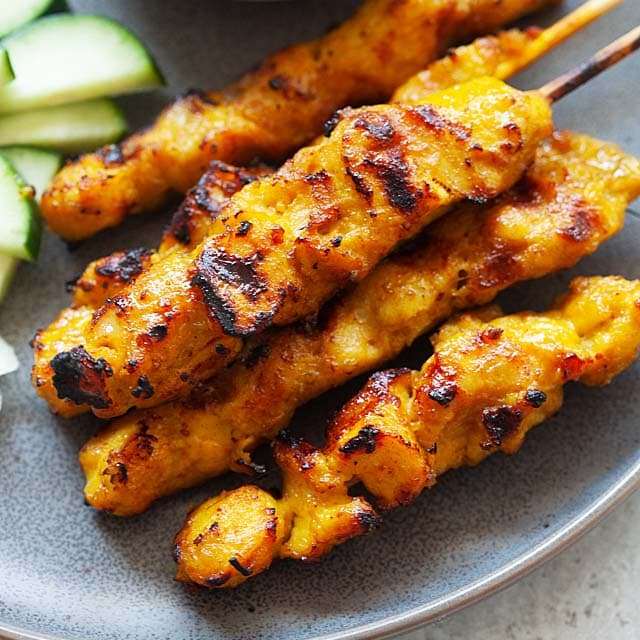
Photo: rasamalaysia.com 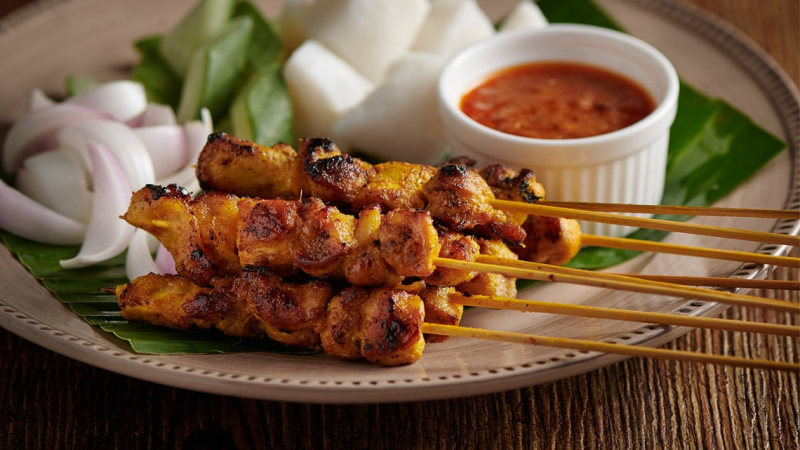
Photo: edulinks.vn -
In Chinese cuisine, Char Siu (Chinese Barbecue Pork) is one of the most popular and widely used roast meats. To tempt you, most restaurants have them hanging in glass cases near the door. To compliment the remainder of their dinner, diners frequently order a platter of this sticky, sweet, and flavorful pork. Others will take it with them as they leave the eatery. Although a case of meat by the entry may not be the most attractive decoration, it may be a very efficient sales approach.
Ingredients
- ½ cup water (120ml)
- 7 oz maltose or honey (200g)
- 2 tbsp Shao Hsing cooking wine
- 4 tbsp hoisin sauce
- 1 tsp five-spice powder
- 1 tsp dark soy sauce
- 2 cloves garlic (minced)
- 1 tsp sesame oil
- 3 lbs pork shoulder (trimmed and cut into thick strips)
Preparation
- Combine ½ cup (120ml) water, maltose, Shao Hsing cooking wine, hoisin sauce, five-spice powder, and dark soy sauce in a small saucepan. Stir to dilute maltose. Bring marinade to a boil.
- Add minced garlic. Reduce heat to medium low and continue to simmer until marinade is thick and syrupy. This should take about 10 minutes.
- Turn off stove. Add sesame oil and allow marinade to cool completely.
- Place pork in a zip top plastic bag. Pour half the marinade into the bag. Press out as much air as possible and zip the bag. Allow pork to marinade in the refrigerator for at least 4 hours or overnight if possible.
- Preheat oven to 375˚F (190˚C). Line a baking tray with aluminum foil. Place a metal rack on the top. Brush some oil on the metal rack.
- Remove pork from the refrigerator. Unzip the bag and transfer pork with a pair of tongs onto the led oiled metal rack.
- Roast pork in preheated oven for 25 to 30 minutes.
- Carefully remove pork from the oven. Brush remaining marinade onto each strip of pork. Turn and brush the other side with more marinade.
- Return the pork to the oven and continue to roast for another 15 minutes.
- When done roasting, remove char siu from the oven. Allow it to rest for 10 minutes before slicing and serving
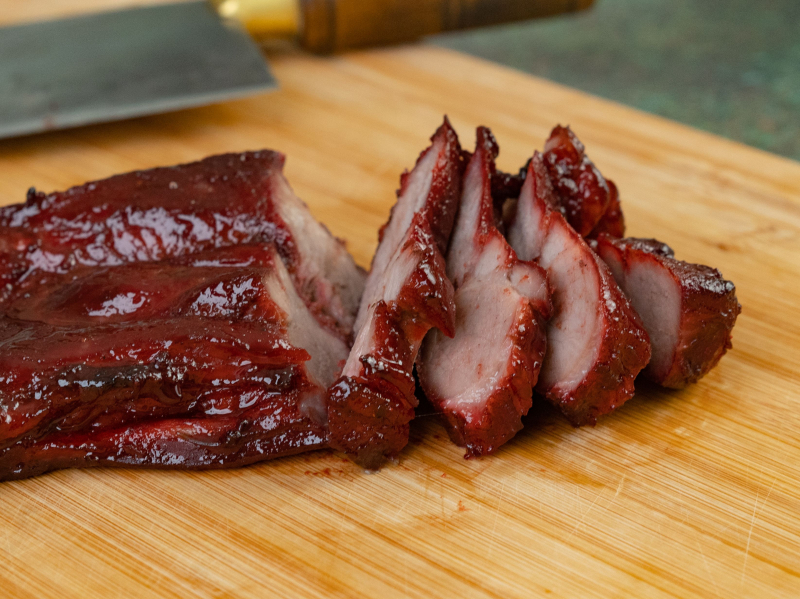
Photo: madewithlau.com 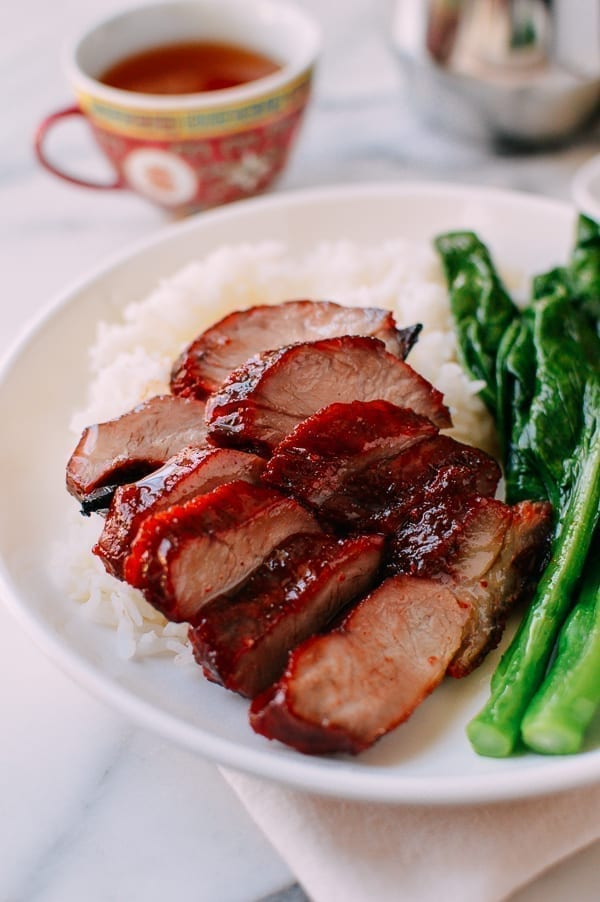
Photo: thvinhtuy.edu.vn -
Kaya toast is a dish consisting of two slices of toast with butter and kaya (coconut jam), commonly served alongside coffee and soft-boiled eggs. Originating from Singapore, the dish is commonly consumed during breakfast. It became integrated into kopi tiam (coffee shop) culture, being widely available in food chains such as Ya Kun Kaya Toast, Killiney Kopitiam and Breadtalk's Toast Box.
Ingredients
- For the Kaya Jam:
- 4 yolks
- 1/3 cups coconut cream
- 1/4 cup granulated sugar
- 3 fresh pandan leaves, tied into a knot
- 1/3 cup dark brown sugar
- For the Kaya Toast:
- 2 slices white bread
- 1 1/2 tablespoons salted butter, thinly sliced
- 1 large soft boiled egg, for serving
- Dark soy sauce, for serving
Preparation
- Gather the ingredients.
- Cut the crusts from the bread, then toast in a skillet or toaster until golden on both sides.
- Lay te thinly-sliced butter over one slice of toast, then spread the kaya jam over the other slice.
- Sandwich the toast together and slice in half. Serve with a soft boiled egg and season with the dark soy sauce.
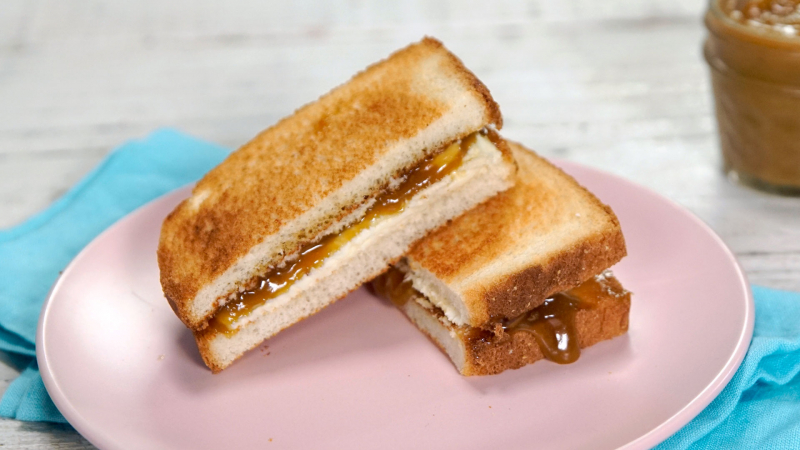
Photo: tastemade.com 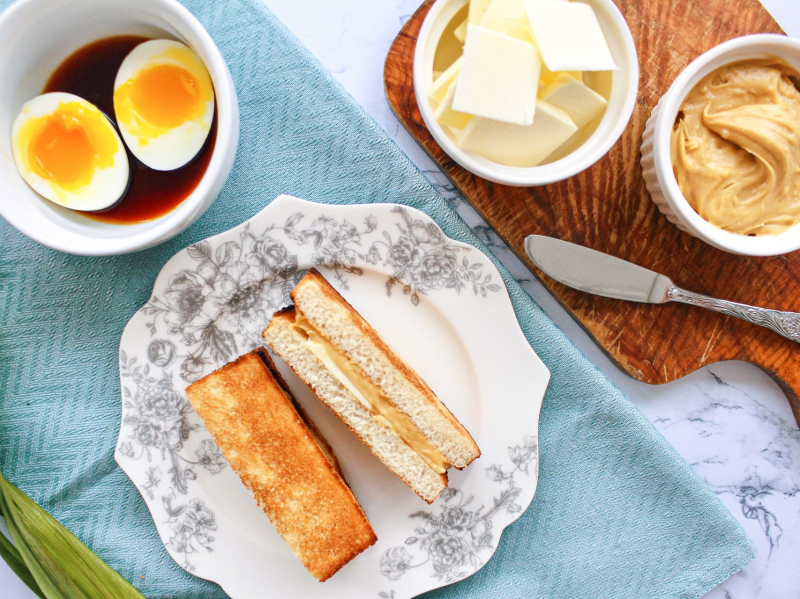
Photo: thespruceeats.com












